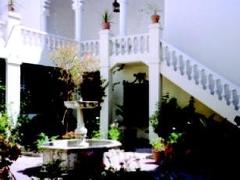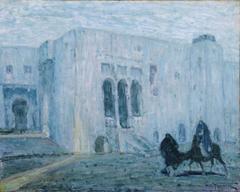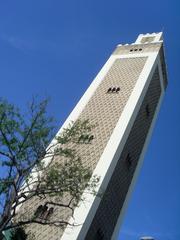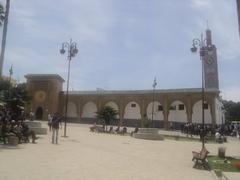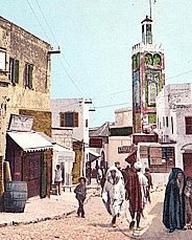Portuguese Tangier Visiting Hours, Tickets, and Historical Sites Guide
Date: 03/07/2025
Introduction to Portuguese Tangier: History, Heritage, and Visiting Essentials
Portuguese Tangier marks a compelling era in the history of Tangier, Morocco, when the city served as a crucial link between Africa and Europe. From 1471 to 1661, Portuguese rule reshaped Tangier’s military, urban, and multicultural identity, leaving enduring marks visible today in its fortifications, architecture, and vibrant medina. Positioned at the intersection of the Atlantic Ocean and Mediterranean Sea, near the Strait of Gibraltar, Tangier attracted Portuguese ambitions, culminating in a successful conquest by King Afonso V in 1471 after earlier failed attempts (Wikipedia; The History Blog).
During two centuries of administration, the Portuguese constructed Gothic castles, bastions like Castelo Velho and Castelo Novo, and transformed religious sites—such as converting the grand mosque into a cathedral, symbolizing Christian authority (PlanetWare; ETSAV PDF). The resulting architectural blend of Portuguese Gothic, Manueline, Moroccan, and Andalusian styles created a unique urban fabric still evident in Tangier’s medina and kasbah (Morocco Trip Time; Moroccan Scene).
As a colonial outpost, Portuguese Tangier balanced military defense, trade, and missionary activity, while frequent resistance—including the pivotal Battle of the Three Kings in 1578—shaped its history (Arab America). The city became a dynamic, multicultural hub of Portuguese settlers and local communities (Pin Your Footsteps). The transfer of Tangier to England in 1661 ended Portuguese rule but left a lasting imprint on the city’s identity (Blue Door Cuisine).
Today, visitors can explore key historical sites such as the Kasbah Museum, Portuguese Walls, Bab Al Bahr gate, and the medina’s fortifications. This guide provides detailed historical context, practical visiting information, and travel tips to help you experience Portuguese Tangier’s enduring legacy.
Table of Contents
- Introduction
- Portuguese Conquest and Establishment (1471)
- Urban Transformation and Fortification
- Daily Life and Administration under Portuguese Rule
- Decline and the End of Portuguese Sovereignty
- Visiting Portuguese Tangier: Key Sites and Practical Information
- Nearby Attractions
- Frequently Asked Questions (FAQ)
- Conclusion
- References and Further Reading
Portuguese Conquest and Establishment (1471)
On August 28, 1471, King Afonso V led a successful campaign to capture Tangier after the city’s population abandoned it following the nearby conquest of Asilah (Wikipedia; The History Blog). Tangier’s strategic position at the Strait of Gibraltar made it a coveted prize for centuries (Pin Your Footsteps; ETSAV PDF). The conquest signaled not just a military victory but also the establishment of European influence at this crossroads of continents.
Urban Transformation and Fortification
Following their victory, the Portuguese initiated major urban changes, reducing the city perimeter to what is now the medina. They constructed a Gothic-style castle and palace, and converted the grand mosque into a cathedral to cement Christian authority (PlanetWare). Over time, additional fortifications such as Castelo Velho and Castelo Novo integrated emerging bastioned designs, prefiguring modern military architecture (ETSAV PDF). The city’s street grid, stone walls, and fortified gates all reflect this era.
Daily Life and Administration under Portuguese Rule
As a Portuguese outpost, Tangier was governed by a military garrison and colonial administrators. The population included both settlers and local residents, contributing to a diverse social landscape (Pin Your Footsteps). Despite persistent local resistance and periodic attacks from Moroccan tribes, the city thrived as a trading hub and missionary base (ETSAV PDF). Artistic and cultural exchanges flourished, blending Portuguese tiles and construction with Moroccan zellij and urban tradition (Morocco Trip Time; Moroccan Scene).
Decline and the End of Portuguese Sovereignty
By the late 16th century, Portuguese influence weakened due to military losses and shifting priorities. The Battle of the Three Kings in 1578 marked a turning point (Arab America). Under the Iberian Union (1580–1640), Tangier’s fortifications were expanded, but in 1661 the city was ceded to England as part of Catherine of Braganza’s dowry (Pin Your Footsteps). The English occupation was short-lived, but the Portuguese legacy endures in the city’s medina, fortifications, and architectural landmarks (Blue Door Cuisine).
Visiting Portuguese Tangier: Key Sites and Practical Information
Major Historical Sites and Monuments
1. Kasbah Museum (Dar el Makhzen)
- Hours: Daily, 9:00 AM–5:00 PM.
- Tickets: 30–50 MAD ($3–$5 USD), discounts for students/children.
- Highlights: Portuguese-era artifacts, ceramics, coins, military relics, and architectural features.
- Accessibility: Some uneven terrain; partial wheelchair access (Enchanting Morocco).
2. Portuguese Walls and Fortifications
- Access: Open 24/7 as part of the historic district.
- Features: Bastions, panoramic viewpoints, and architectural details.
- Tours: Guided and self-guided options available (Vagrants of the World).
3. Bab Al Bahr Gate
- Access: Open at all times.
- Location: Near the Kasbah, overlooking the harbor.
4. Former Cathedral (Grand Mosque Site)
- Hours: Tuesday–Sunday, 10:00 AM–4:00 PM.
- Tickets: Usually free or included in museum passes.
- Features: Gothic arches, Christian iconography, and stone columns.
5. The Medina and Portuguese Urban Footprint
- Tips: Best explored on foot; guided tours available for deeper historical context.
Visiting Hours and Ticket Information
- Most sites: 9:00 AM–5:00 or 6:00 PM.
- Kasbah Museum: 30–50 MAD.
- Portuguese Cistern: 20 MAD.
- No fee: Portuguese Walls and fortified gates.
- Combined tickets: Sometimes available at site entrances or via official tourism operators.
Guided Tours and Accessibility
- Guided tours: Highly recommended for historical context; available through local agencies and hotels for 200–600 MAD ($20–$60 USD), lasting 2–6 hours (Switch Bridge Tours).
- Accessibility: The medina and kasbah have steep, uneven streets; some sites have wheelchair access. Contact sites or guides in advance to confirm.
Events and Visitor Tips
- Cultural festivals: Include Tanjazz (September), the International Film Festival (November), and Ramadan festivities.
- Best times to visit: Early morning or late afternoon for milder weather and better light.
- Dress and etiquette: Modest clothing; seek permission before photography (Local Adventurer).
- Safety: Tangier is generally safe, but watch for pickpockets in crowds (Must Visit Morocco).
Nearby Attractions
- Cap Spartel: Where the Atlantic meets the Mediterranean; panoramic views.
- Caves of Hercules: Natural wonder with mythic significance.
- American Legation Museum: Tangier’s diplomatic history, 9:00 AM–5:00 PM.
Frequently Asked Questions (FAQ)
Q: What are the Kasbah Museum’s visiting hours?
A: 9:00 AM–5:00 PM daily.
Q: Are tickets required for the Portuguese Walls?
A: No, the walls are open-access.
Q: Are guided tours available?
A: Yes—book through local agencies, hotels, or tourist offices.
Q: Is the historic center accessible for those with mobility issues?
A: Some areas are challenging due to steep and uneven streets. Select museums offer wheelchair access; contact in advance for assistance.
Q: What is the best way to get around?
A: Walking is ideal for the historic center; petit taxis and hop-on, hop-off buses serve longer distances (Road Affair).
Conclusion
Portuguese Tangier represents a unique chapter in the city’s story—a crossroads where European and North African cultures intertwined and left an indelible mark on urban life, architecture, and heritage. From the fortress walls and medina streets to the Kasbah Museum’s treasures, visitors can immerse themselves in centuries of history. Plan your visit with attention to opening hours, ticketing, and accessibility to fully enjoy these sites. For up-to-date information, guided tours, and travel inspiration, download the Audiala app and connect with us online.
Recommended Images & Alt Tags:
- “Portuguese Walls Tangier panoramic view”
- “Kasbah Museum entrance, Portuguese Tangier”
- “Bab Al Bahr gate overlooking the harbor, Tangier”
- “Historic Portuguese Cistern in Tangier”
- “Sunset view at Cap Spartel, Tangier”
Suggested Internal Links:
- Top Things to Do in Tangier
- Guide to the Medina of Tangier
- Day Trips from Tangier: Asilah and Beyond
References and Further Reading
This article is supported by the following sources:
- Wikipedia
- The History Blog
- Pin Your Footsteps
- ETSAV PDF
- PlanetWare
- Blue Door Cuisine
- Moroccan Scene
- Morocco Trip Time
- Arab America
- Maproom44
- Morocco World News
- Vagrants of the World
- Enchanting Morocco
- Switch Bridge Tours
- Audiala
- Dardif
- Tangier Escapade
- Road Affair
- The Crazy Tourist
- GoWithGuide
- Must Visit Morocco
- Passaporte no Bolso
- HikersBay
- Local Adventurer
- The Wildest Road
